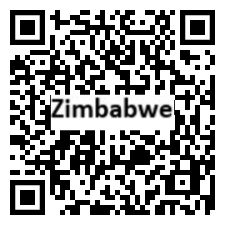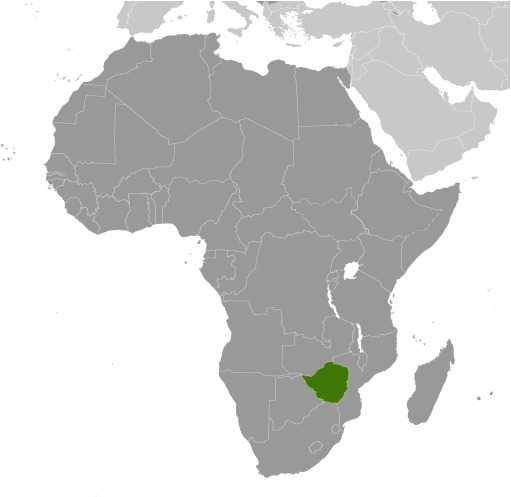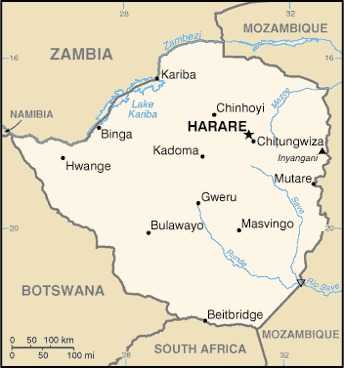Introduction
Background
A series of trading states developed in the area of Zimbabwe prior to the arrival of Europeans. The largest of these was the Kingdom of Zimbabwe (ca. 1220-1450). UK colonization in the late 1800s led to the creation of Southern Rhodesia in 1923. In 1965, the government declared independence, but the UK did not recognize the act and demanded more rights for the Black African majority in the country (then called Rhodesia). UN sanctions and a guerrilla uprising led to free elections in 1979 and independence (as Zimbabwe) in 1980.
Geography
Area
total: 390,757 sq km
land: 386,847 sq km
water: 3,910 sq km
Climate
tropical; moderated by altitude; rainy season (November to March)
Natural resources
coal, chromium ore, asbestos, gold, nickel, copper, iron ore, vanadium, lithium, tin, platinum group metals
People and Society
Population
total: 17,150,352
male: 8,343,790
female: 8,806,562 (2024 est.)
Ethnic groups
African 99.6% (predominantly Shona; Ndebele is the second largest ethnic group), other (includes caucasian, Asiatic, mixed race) 0.4% (2022 est.)
Languages
Shona (official; most widely spoken) 80.9%, Ndebele (official, second most widely spoken) 11.5%, English (official; traditionally used for official business) 0.3%, 13 minority languages (official; includes Chewa, Chibarwe, Kalanga, Koisan, Nambya, Ndau, Shangani, sign language, Sotho, Tonga, Tswana, Venda, and Xhosa) 7%, other 0.3% (2022 est.)
Religions
Apostolic Sect 40.3%, Pentecostal 17%, Protestant 13.8%, other Christian 7.8%, Roman Catholic 6.4%, African traditionalist 5%, other 1.5% (includes Muslim, Jewish, Hindu), none 8.3% (2022 est.)
Population growth rate
1.91% (2024 est.)
Government
Government type
presidential republic
Capital
name: Harare
Executive branch
chief of state: President Emmerson Dambudzo MNANGAGWA (since 4 September 2023); First Vice President Constantino CHIWENGA (since 4 September 2023); Second Vice President Kembo MOHADI (8 September 2023); note - Robert Gabriel MUGABE resigned on 21 November 2017, after ruling for 37 years
head of government: President Emmerson Dambudzo MNANGAGWA (since 4 September 2023); First Vice President Constantino CHIWENGA (since 4 September 2023); Second Vice President Kembo MOHADI (8 September 2023)
Legislative branch
description: bicameral Parliament consists of:
Senate (80 seats; 60 members directly elected in multi-seat constituencies - 6 seats in each of the 10 provinces - by proportional representation vote, 16 indirectly elected by the regional governing councils, 18 reserved for the National Council Chiefs, and 2 reserved for members with disabilities; members serve 5-year terms)
National Assembly (280 seats; 210 members directly elected in single-seat constituencies by simple majority vote and 60 seats reserved for women directly elected by proportional representation vote and 10 additional seats reserved for candidates aged between 21 and 35 directly elected by proportional representation, members serve 5-year terms)
Economy
Economic overview
low income Sub-Saharan economy; political instability, protest crackdowns, and COVID-19 have damaged economic potential; reliant on natural resource extraction and agriculture; endemic corruption; ongoing hyperinflation
Real GDP (purchasing power parity)
$36.035 billion (2022 est.)
$33.829 billion (2021 est.)
$31.188 billion (2020 est.)
Real GDP per capita
$2,200 (2022 est.)
$2,100 (2021 est.)
$2,000 (2020 est.)
Agricultural products
sugarcane, maize, beef, milk, cassava, wheat, bananas, vegetables, tobacco, cotton (2022)
Industries
mining (coal, gold, platinum, copper, nickel, tin, diamonds, clay, numerous metallic and nonmetallic ores), steel; wood products, cement, chemicals, fertilizer, clothing and footwear, foodstuffs, beverages
Exports
$5.263 billion (2020 est.)
$5.267 billion (2019 est.)
$5.178 billion (2018 est.)
Exports - partners
UAE 57%, South Africa 17%, China 7%, Belgium 4%, Mozambique 2% (2022)
Exports - commodities
gold, nickel, tobacco, iron alloys, diamonds (2022)
Imports
$5.489 billion (2020 est.)
$5.398 billion (2019 est.)
$7.642 billion (2018 est.)
Imports - partners
South Africa 39%, China 15%, Singapore 12%, UAE 6%, Mozambique 4% (2022)
Imports - commodities
refined petroleum, fertilizers, trucks, soybean oil, electricity (2022)
Exchange rates
Zimbabwean dollars (ZWD) per US dollar -
Exchange rates:
374.954 (2022 est.)
88.552 (2021 est.)
51.329 (2020 est.)
16.446 (2019 est.)
322.355 (2018 est.)
Page last updated: Tuesday, May 07, 2024




